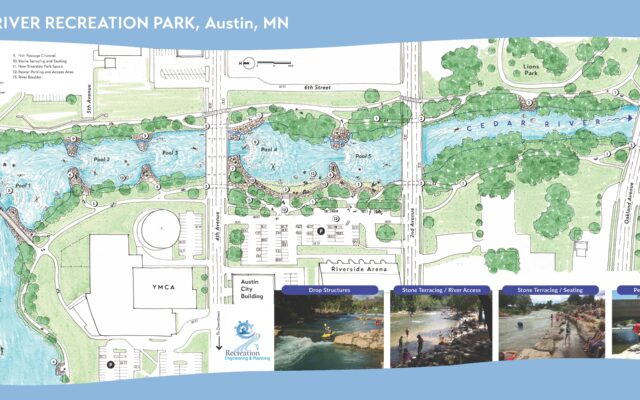Whitewater study details concept for Cedar River in Austin

Creating a series of five whitewater drops to replace the Cedar River State Water Trail’s downtown Austin dam could cost an estimated $10 million but would be a viable project, according to a feasibility study.
Members of the local Austin Whitewater on the Cedar committee this week are releasing the study’s findings on replacing the dam below the Fourth Avenue Northeast bridge with a whitewater course and significantly improve public access along both shorelines for fishing, relaxing and interacting with the river.
If built, as of now, Austin would have the first whitewater course in Minnesota and would be the closet attraction of this kind to the Minneapolis-St. Paul metro area.
Under the proposal, the Cedar River at Austin Milld Pond, created by the dam, would retain the same surface-water elevation, which was a priority of the committee. The study proposes starting the drop features at the pedestrian bridge near the new YMCA and creating the final one upstream of the Second Avenue Northeast bridge. Three drops would be above today’s dam, with a fourth created at the site of the dam, which mostly would be removed. A fifth drop would be just downstream.
Whitewater committee members presented the findings and took questions from the public Tuesday night at the Austin Public Library. On Monday, the group also updated the Austin City Council.
Nate Smit, the whitewater group leader said a major positive of the whitewater course, if built, is that it would be a free attraction for people of all income levels, abilities and interests while also cleaning up a historic but blighted part of town. This also would improve public safety in relation to the dam, which poses hazards for those on the water and, as often seen, those who climb out onto the dam’s different parts.
Recreation Engineering & Planning (REP), a firm based in Boulder, Colo., was hired to complete the feasibility study, which involved REP leadership – Gary Lacy and his son, Spencer – visiting Austin for two days in May 2023. REP designed the whitewater course on the Cedar River in Charles City, Iowa, and has done dozens of others nationwide.
Smit first pitched the whitewater idea a few years ago to local government staff after visiting Charles City’s whitewater course.
Extensive stone bank terracing is proposed for along the last, two pools – between Fourth and Second avenues – because they would draw the most spectators and shoreline users. A pedestrian trail is proposed for the river’s west side to go under the bridges.
Narrow, side channels called “fish ladders” would be built on the river’s east side to allow fish and other aquatic species to migrate up and down the river, which the dam prevents today. Pools of varying depths and each about 200 feet long behind each drop feature would provide new areas for shoreline fishing.
The study also looked at how the whitewater structures would handle flooding and found no negative effects.
REP wrote that while the Cedar River is a small river in its headwaters area of Mower County, it has enough water to provide for quality whitewater features for most of the year. Many popular whitewater parks have similar flows.
All property on both sides of the project area except for one parcel is owned by the City of Austin.
Smit was one of the library event’s speakers along with guest Hannah Ray J, a multi-disciplined whitewater athlete who paddles and surfs year-round at whitewater courses, especially in Iowa. Ray J’s paddling endeavors began on a whitewater course on the Maquoketa River in Manchester, Iowa (northeast Iowa) that also was designed by REP. REP leaders Gary Lacy and his son, Spencer Lacy, visited the Austin site for two days in May 2023.
Austin first built a dam on the Cedar River near downtown in 1864 to harness the river’s water to power a grain mill. Today’s version of the dam, built from concrete, is about 100 years old and nearly 11 feet tall, with a western section that is slighter higher and mostly remains dry during the year.
Whitewater committee members plan to continue sharing the study with the public, gathering feedback and looking into possible funding sources for the next design phase needed for governmental permitting and grant applications. At this point, no additional local tax funding is being requested for the project.







